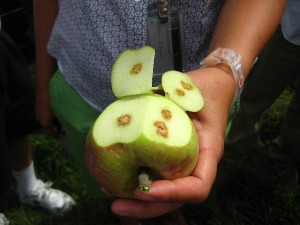Double-Trouble Bug Problem Really Stinks
April 2nd, 2011
It was bad enough when a stinky imported stink bug showed up to invade our houses by the gazillions in winter.
Now this same bug is poised to become a serious agriculture and home-garden pest as well – feasting on everything from apple orchards to backyard tomatoes.
That’s right, the Asian brown marmorated stink bug is double trouble… and especially ominous since we’ve really got nothing to control its spread.
“It’s one of the worst pests I’ve ever seen,” says Dr. Paula Shrewsbury, an entomologist at the University of Maryland who’s part of a national group – dubbed the “stink bug summit” – that’s scrambling to deal with this crawling upstart.
“This is a new bug that hasn’t reached its heyday yet,” she says. “I think we’ll see damage surpass last year.”
Although the brown marmorated stink bug first showed up in the late 1990s in Allentown, it wasn’t until last season that its numbers swelled enough here that its outdoor carnage became apparent.
In the next few weeks, stink bugs will be heading back outside after their in-your-house winter vacation.
Dr. Greg Krawczyk, an entomologist at Penn State’s Fruit Research and Extension Center in Adams County, saw last year’s ballooned population cause up to 60 percent losses in some orchards.
The warm growing season might have been a factor.
“They like it hot,” says Krawczyk. “They can have one to seven generations per year in Asia. We thought we’d have one generation a year in Pennsylvania, but last year we had at least two.”
Brown marmorated stink bugs pierce into ripening fruits and suck out juices, causing disfigured dry spots that don’t render fruits inedible but make them unsellable.
“The main issue is the number of stink bugs out there,” says Krawczyk. “This is actually only one of about 20 different stink-bug species. Most are not a problem because they’re being controlled by natural enemies.”
Being the new kid on the block, the brown marmorated stink bug has no effective enemy here and is spreading virtually unchecked. It’s now been identified in 30 U.S. states.
At best, predators are eating into only about 10 percent of the brown marmorated population, says John Tooker, an assistant professor of entomology at Penn State.
“These aren’t easy to kill either,” says Tooker.
For one thing, stink bugs don’t take in as much of an insecticide as a leaf-eating insect since they suck out interior plant juices instead of feasting on chemical-coated leaves.
But as growers and gardeners have moved to more environmentally friendly pesticides with shorter residual action, a wave-after-wave pest like this stink bug has plenty of reserves to weather the defense.
“You may kill stink bugs that are on your plants at the time,” says Shrewsbury, “but these bugs are very mobile. Even if you kill them today, more will be back next week.”
Another problem is the apparent non-picky appetite of the brown marmorated stink bug.
“In its native range, this stink bug not only attacks fruits but also a wide variety of ornamentals,” says Shrewsbury. “We know of at least 45 species it attacks in Asia. So far in the U.S., we’ve identified 60 species.”
Among its fruit and veggie favorites are tomatoes, beans, peppers, soybeans, corn, apples, peaches, Asian pears, blueberries, raspberries and grapes.
Around the landscape, favorite ornamentals include crabapple, hawthorn, serviceberry, butterfly bush, roses, abelia, honeysuckle, redbud, dogwood, maple, catalpa and elm.
So what’s a stink-bugged gardener to do?
Rutgers University insecticide studies identify cyfluthrin, bifenthrin and deltamethrin as three effective sprays that a home gardener can use on ornamentals (and selected edibles… so read the label carefully!)
Other broader-spectrum sprays also may work, but entomologists are concerned that widespread use of those may do more harm than good.
“What we’re concerned about is a rush to insecticide use,” says Tooker. “A lot of times you’re doing far more damage than good, mainly by knocking out the beneficial-insect population.”
In other words, you may slightly and temporarily control a stinkbug invasion but unleash an array of other bug trouble that was being checked by the “good bugs.”
Shrewsbury suggests using netting and row covers to physically protect crops where possible and to hand-pick or vacuum populations that are causing unacceptable damage.
Ultimately, entomologists are confident a solution will be found – whether by trapping, insecticide, natural predator, disease, genetics or a combination of all of the above.
Most promising is finding a pheromone that would lure stink bugs into what they think is a mating situation.
Sterling International, a Washington-based garden-products company best known for its Japanese beetle traps, plans to unveil a pheromone-based Rescue Stink Bug Trap this July. The company claims the trap will capture adult stink bugs before they ruin your tomatoes or fly into your house when the weather gets cold.
What remains to be seen is how effective this early pheromone will be and whether the $20 traps will make a noticeable dent in the problem.
“We’re going to look at a number of different traps so, hopefully, we can get some real data before people start spending money on unproven products,” says Krawczyk.
What’s for sure is that last year wasn’t a fluke stink-bug flare-up.
“They are here,” Krawczyk says. “It is not a one-year thing.”
Adds Tooker: “We’re telling people to prepare for the worst.”









